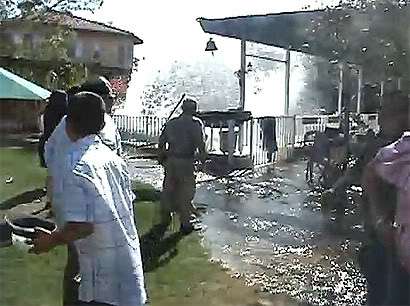
* By now, everyone has their own stories about where they were and what they were doing -- during last week's "monster" 7.2 earthquake that began in northeastern Baja California, Mexico -- and rumbled through southern California and Arizona -- shaking hearts and unsecured objects as far north as Santa Barbara. (I'll explain why I put the word, "monster" in quotes in a moment.)

* Other than my irritation with television stations refusing to "cut-away" from their infomercials -- AND with national news outlets initially focusing on the quake's impact in Los Angeles, as if San Diego is still a surburban "afterthought" (which by the way, New York editors wouldn't dare to attempt if the quake was situated in Philadelphia, roughly the same distance as L.A. is to San Diego) -- I heard very few people expressing thanks about stringent building codes in the United States, which played a big part in minimizing casualties and damage.

* While heavy damage was reported in El Centro, Calexico, Mexicali -- and throughout the rest of the Imperial Valley located roughly 100 miles east of San Diego -- the loss of life within the region's municipalities was greater than 1 and less than 10, according to conflicting news reports. Quakes of such magnitude and their subsequent tsunamis have killed thousands of people in other regions of the world, even when their epicenters are 150 to 300 miles away.

* But not here in the U.S. I'm not saying this would hold if last Sunday's quake involved the legendary San Andreas Fault. But a "7.2" is still a "7.2," especially if you're located a mere 100 miles from its epicenter. The post-quake result was a "monster" shaker by every standard measure -- but it turned out to be "merely" one of the "scariest but safest roller coaster rides" in county history. We heard a lot of talk about broken dishes and plate glass windows -- but nothing as traumatic as the evacuations of 500,000 people during the enormous brush fires that hit San Diego county in October 2007.

* Today's blurb collects two of the scores of videos I inspected about the quake that have been posted throughout the Internet. The first is from Sharon Weaver-Anderholt -- whose home is in Brawley, California, located about 130 miles east of San Diego and 20 miles north of El Centro. Mrs. Anderholt, a retired school administrator in the Imperial Valley, consented to my posting her 59-second video on You Tube, which has thus far has recorded more than 100,000 hits. Click below.
* According to Mrs. Anderholt, "We lost 6-7 inches of water out of our pool. We were really rocking and rolling, slow and easy. It was splashing much higher prior to me filming."

* The second video was posted yesterday by Arturo Marin and Adam Lazarin. They were filming an Easter party in progress in Calexico, California -- when the shaker hit. This 108-second video is more frightening because the people in it are clearly panicking. Click below.
* We'd all like to think that we'd be cool and calm under pressure. But the video above, which was closer to the quake's epicenter, shows otherwise. Equally frightening is how long it took for people to just fall to the ground and stay out of harm's way. Despite all the lessons we've been taught about what to do when the "big one" hits, I've heard from many people who confess that they did all the wrong things. They just "rode things out" -- or stayed in dangerous areas of their homes -- not even getting close to their doorways.

* What's unsettling is geologists continue to predict that we're still due for "a big one." Having gone through a shared communal experience, how long will it take before the lessons of the Easter quake of 2010 -- dissipate -- leaving us equally unprepared when the "big one" does hit?

* I know one writer from the San Diego Union-Tribune who said he felt nothing during the quake. He said he was pulling weeds in his backyard when it happened. Why do I feel sorry for him? I'm not sure, but I think it's because he missed experiencing something great, that is, the full power of something that's beyond man's control.
Original material © 2010 by David Kusumoto Communications.






